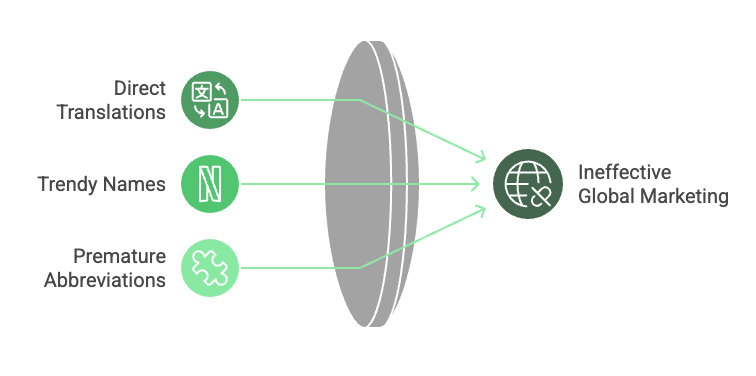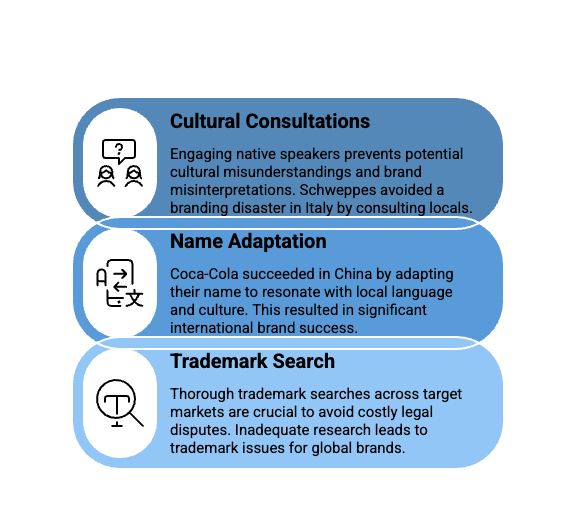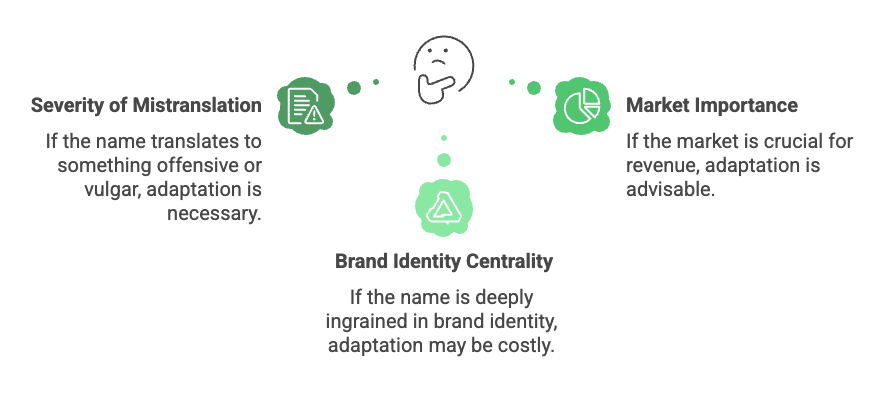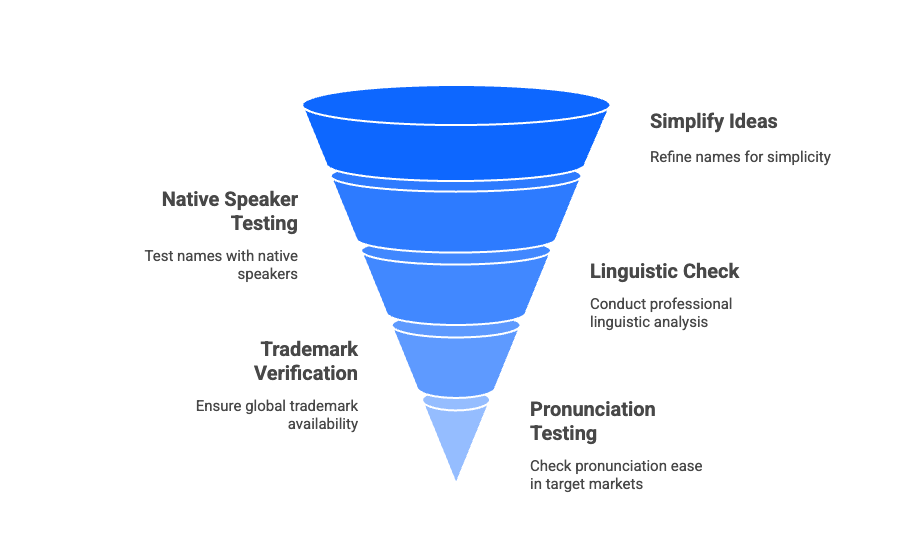Hey entrepreneurs, let’s talk about some big mistakes in the naming process that can really sink your business internationally. If you’re starting a new business, make sure the name you want is easy to pronounce and has a matching domain name. No one wants to deal with loss of brand because the name choices are a mouthful!
Picking a name for your brand is one of the most crucial decisions you'll make. But when you're eyeing global markets, the stakes get even higher. A name that works in your backyard might be laughable—or worse, offensive—across borders. Let's dive into why these mistakes happen and how you can avoid them without flushing your marketing budget down the drain.
The Complexity of International Brand Names
Creating a brand that travels well isn't just about translation. It's about cultural context, local slang, and regional sensibilities.
The challenge is real: 72% of consumers actively avoid brands with culturally insensitive names. That's three-quarters of your potential market walking away before they even try your product.
When you're naming something that needs to work worldwide, you're playing a high-stakes game of linguistic pinball. One wrong bounce and you could end up like Ford did with their Pinto in Brazil—where the name translates to something you definitely wouldn't put on a showroom floor, as detailed in these brand names lost in translation examples.
The Real Cost of Branding Mistakes
The price tag on a naming mistake isn't small change. Inconsistent branding costs companies up to 20% in potential growth. That's a fifth of your business gone because of letters strung together in the wrong way.
Consider the cash Mercedes-Benz burned through when they had to rebrand in China after discovering their chosen name "Bensi" translated roughly to "rush to die," as documented in this collection of worst brand translations. Not exactly the luxury car messaging they were aiming for.
Most Common Cross-Cultural Naming Fails
Let's get specific about where brands typically stumble when going global:
-
Direct translations without cultural checks - Ford's Pinto is the classic example, but KFC's slogan translating to "Eat Your Fingers Off" in Chinese shows this problem hasn't gone away, according to cross-cultural marketing experts.
-
Trendy but meaningless names - Overusing suffixes like "-ify" or "-io" leads to forgettable or nonsensical names that mean nothing in other languages.
-
Premature abbreviation - Mimicking established giants like IBM by abbreviating too early confuses new international audiences who don't have the context to understand what those letters mean.

When Pepsi entered the Chinese market, their slogan accidentally translated to "Bring ancestors back from the grave." Not exactly the refreshing vibe they were going for.
Learning from Success: Brands That Got It Right
While failure stories grab headlines, several brands demonstrate how thoughtful international naming creates competitive advantages.
-
Google's name works globally because it's based on "googol" (a mathematical term), making it culturally neutral while remaining memorable across languages.
-
Spotify cleverly combines "spot" and "identify," creating a coined word that's easy to pronounce worldwide and doesn't carry cultural baggage.
-
BMW maintained its German abbreviation globally but invested heavily in positive brand associations, turning potential pronunciation challenges into premium positioning.
-
Perhaps most impressive is Häagen-Dazs, which created a completely fictional Scandinavian-sounding name that suggests premium quality across cultures without being tied to any specific language or region.
These brands succeeded by prioritizing universal appeal, phonetic simplicity, and cultural neutrality from day one.
Essential Testing Methods for Global Brand Names
Smart companies don't just hope for the best—they test thoroughly before committing:
-
Cultural consultations with native speakers are essential. Schweppes avoided a disaster in Italy where their name could have been associated with "toilet water" by testing with locals first.
-
Coca-Cola got it right in China by adjusting their name to "Kě kǒu kě lè," which means "tasty fun" after initial mistranslations. The result? One of the most successful international brand adaptations in history.
-
A proper trademark search across all target markets is non-negotiable. 20% of global brands face trademark disputes due to inadequate research—an expensive legal headache you can avoid with upfront homework.

The Limitations of Geographically Tied Brand Names
A common mistake is choosing names that are too culturally narrow. Scalable naming means avoiding geographic or culturally specific terms that won't travel well.
The cautionary tale here is "Barf" soap from Iran, which works fine locally but causes English speakers to recoil. Your brand might be geographically limited before it even starts.
The solution isn't necessarily creating culturally bland names. Rather, it's finding names that can retain meaning while traveling well. Brands like Nike (named after the Greek goddess of victory) manage to feel both culturally rich and internationally accessible.
The key is conducting thorough cross-cultural research before finalizing any name. This means testing potential names across all target markets and being particularly vigilant about negative associations. Sometimes the best approach is finding names with positive meanings in multiple languages or creating coined words that carry no pre-existing cultural baggage.
Market-Specific Naming Strategies
There's a reason why brands like Google and Tesla work worldwide: they prioritize phonetic simplicity and universal meanings. These names are easy to say in almost any language and don't carry cultural baggage. But sometimes adaptation is necessary. The decision depends on:
The severity of the potential mistranslation
Not all translation issues are created equal. If your brand name translates to something mildly odd or slightly confusing, you might proceed with caution. But if it translates to something deeply offensive, vulgar, or associated with tragedy in a key market, adaptation becomes non-negotiable.
Take Chevrolet's "Nova" car, which struggled in Spanish-speaking markets because "no va" can be interpreted as "doesn't go" - not ideal for a vehicle. The severity scale ranges from "slightly awkward" to "brand-killing offensive," and your response should be proportional.
The importance of the market to your business
Market prioritization matters in naming decisions. If China represents 40% of your potential revenue, you'd be foolish to stick with a name that doesn't work there just to maintain brand consistency. Coca-Cola recognized China's importance and invested heavily in finding the phonetically similar "Kě kǒu kě lè" that also carried positive meanings.
Conversely, if a market represents just 2% of your potential business, you might accept some minor naming compromises there. Simply put: the more critical the market, the more willing you should be to adapt.
Whether the name is central to your brand identity
Some brand names are more foundational than others. If your name embodies your core values or has decades of equity built into it, adaptation becomes more costly beyond just marketing expenses. Apple's brand is so central to its identity that it maintains consistency across markets despite occasional cultural challenges.
However, if your name is merely functional rather than central to your story, being flexible about adaptation makes more strategic sense. Consider whether your name carries your brand's essence or is just a label – this fundamentally impacts your adaptation calculus.

Pronunciation Challenges in Global Branding
Names that native English speakers find simple might be tongue-twisters elsewhere. And if customers can't say your name, they can't ask for your product.
Consider sounds that don't exist in certain languages. The "th" sound in English doesn't exist in many languages, making names like "Thrive" challenging for global use.
Your name should be easy to say across languages that matter to your business. Otherwise, you're creating an unnecessary barrier between your customers and your cash register.
Cultural Significance of Numbers and Symbols
Numbers and symbols carry different meanings across cultures. A key challenge is balancing creativity with cultural taboos, like avoiding the number "4" in Japan where it's associated with death.
Similarly, certain colors and symbols in logos paired with your name can change meaning drastically across borders. Red means good luck in China but danger in other countries.
The lesson? Don't just check your word—check everything associated with it.
Balancing Creativity With Cross-Cultural Safety
Finding the sweet spot between a name that stands out and one that travels well is tough. Here's a simple framework:
-
Start creative but keep it simple
-
Test with native speakers from target markets
-
Run a professional linguistic check
-
Verify trademark availability globally
-
Test for pronunciation ease

The goal isn't to water down your brand but to make sure your creativity doesn't accidentally create problems.
International Legal Considerations in Brand Naming
Trademark laws vary wildly from country to country. A name you've cleared in your home market might be someone else's property elsewhere.
The United States Patent and Trademark system won't protect you in China, Europe, or elsewhere. Each market requires its own search and potentially its own registration.
Be especially wary of trademark squatters in some markets who register foreign brand names before the original companies enter the market.
The Dangers of Trend-Chasing in Global Naming
Trends change fast, but changing your brand name doesn't. What sounds cutting-edge today may feel dated tomorrow—especially across different markets where trends move at different speeds.
Brands that chase trends with suffixes like "-ify" or "-io" often end up sounding generic or confusing to international audiences.
Instead, aim for timeless over trendy. Your brand may need to live in multiple markets for decades.
FAQs
What are some common brand naming mistakes I should be aware of?
When it comes to naming your business, there are a few classic mistakes to avoid. First, steer clear of names that are too similar to existing brands. You don't want to get tangled up in a trademark issue. Second, avoid names that are hard to pronounce or spell
Lastly, don’t choose a name that doesn’t reflect your brand identity. Your company name should resonate with what you’re all about!
How can I ensure my business name is unique?
Great question! Start by doing a thorough search to see if the name you’re considering is already taken. Check online for existing domain names, social media handles, and, of course, trademark registrations. A simple Google search can reveal a lot.
Are there any descriptive names I should avoid?
Yes! While it might be tempting to go for a descriptive name that explains what you do, these can often be too generic. Names like "Best Coffee Shop" or "Affordable Plumbing" might not stand out in a crowded market. Instead, think outside the box and choose a name that’s unique and reflects your brand identity.
What’s a classic example of a branding mistake?
One classic example is the company "Coca-Cola" almost naming one of its drinks "Coke." While it seems catchy now, the name was too close to "Coke" in slang terms, which could have led to some confusion.
Always remember that your company name should be distinct enough to stand on its own!
